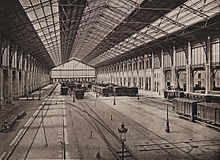Paris-Austerlitz train station
| Paris-Austerlitz | |
|---|---|
|
Reception building (2006)
|
|
| Data | |
| Location in the network | Terminus |
| Design | Terminus |
| Platform tracks | 21 (including 4 in the basement) |
| IBNR | 8700010 |
| opening | September 20, 1840 |
| Architectural data | |
| architect | Pierre-Louis Renaud |
| location | |
| City / municipality | Paris |
| Department | Paris |
| region | Île-de-France |
| Country | France |
| Coordinates | 48 ° 50 '30 " N , 2 ° 21' 58" E |
| Railway lines | |
| List of train stations in France | |
The Paris-Austerlitz station , colloquially Gare d'Austerlitz (German Austerlitz station, originally Gare d'Orléans ) is one of the six terminal stations in Paris . It is located in the 13th arrondissement in the Quartier de la Salpêtrière on the left bank of the Seine .
Surname
The name of the station comes from the Moravian town of Austerlitz , where Napoléon Bonaparte fought victoriously in the Battle of the Three Emperors on December 2, 1805 against the numerically superior Austro-Russian troops. To commemorate this historic victory, the warship Austerlitz of the French Navy and the Quai d'Austerlitz in Paris were named after the site of the battle in addition to the station .
history

As early as 1840, due to the opening of the Paris – Corbeil line , the first station was built on the site of the current one. That line was extended to Orléans in 1843 . The station was enlarged for the first time in 1846.
The station was rebuilt between 1862 and 1870. The new metal station hall has a considerable span of 51.5 meters for the construction time and is 280 meters long. The great room was used to make hot air balloons during the siege of Paris in 1870 .
In 1900, the operating company of the railway line, the Compagnie du Chemin de fer de Paris à Orléans (PO), extended the route towards the center of Paris. The Gare d'Orsay station, which opened on July 14, 1900 on the occasion of the world exhibition , was the new terminus for long-distance trains until 1939.
In 1906, the elevated railway station of the Paris Métro of the same name went into operation. Their tracks and platforms cross the station hall at right angles above the railway systems.
On November 2, 1941, a serious railway accident occurred when an express train arriving from Orléans collided with an empty train. 21 people died and seven were also injured.
In 2013, the side wing with the station restaurant Le Grenadier was demolished.
traffic
Since the commissioning of the high-speed line LGV Atlantique , the station has lost most of the long-distance train connections in the south-west to Gare Montparnasse station . Its passenger traffic is 25 million passengers per year (68,000 per day), which is half of the traffic at Gare Montparnasse station.
The station is the end point of all (as of 2019 remaining) night trains within France (to Briançon , Albi , Latour-de-Carol and Portbou ), the international night trains depart from Paris Gare de Lyon (to Milan - Venice), and previously also from Gare de l 'Est (towards Germany).
In addition to the remaining SNCF trains, lines 5 and 10 of the Paris Métro and RER line C also operate .
future
Gare d'Austerlitz is the only one of the six Paris train stations that is not fully used. With the construction of the LGV Sud Europe Atlantique to Bordeaux, the plan is to offer TGV trains from this station for the first time in 2020 , as the Montparnasse station is already being used to its limits. A four-track extension was built especially for this purpose, for which the station restaurant Le Grenadier had to give way. The rails then continue under Avenue de France to Bibliothèque François Mitterrand station . The completion of the construction work is planned for 2020, the costs for the project, including the renovation of the main hall and the listed facade, amount to 600 million euros.
Track apron, behind it the building of the French National Library
literature
- Philippe Callé: the first without steam engines . In: Railways in Paris = Railway History Special 2 (2015). ISBN 978-3-937189-94-9 , pp. 34-37.
Web links
- SNCF station information
- Official website of the SNCF
- Official website of the RATP
- Official information about the new buildings ( page no longer available )
- Gare d'Austerlitz on Forvo.com
Individual evidence
- ^ Jean Tricoire: Un siècle de métro en 14 lignes. De Bienvenüe à Météor . La Vie du Rail, Paris 2004, ISBN 2-902808-87-9 , p. 196
- ^ Peter WB Semmens: Catastrophes on rails. A worldwide documentation. Transpress, Stuttgart 1996, ISBN 3-344-71030-3 , p. 106.
- ↑ Massacre à Austerlitz! at parisperdu.blogg.org, accessed on February 29, 2020
- ↑ La gare d'Austerlitz va s'offrir un balcon sur la Seine , lefigaro.fr










